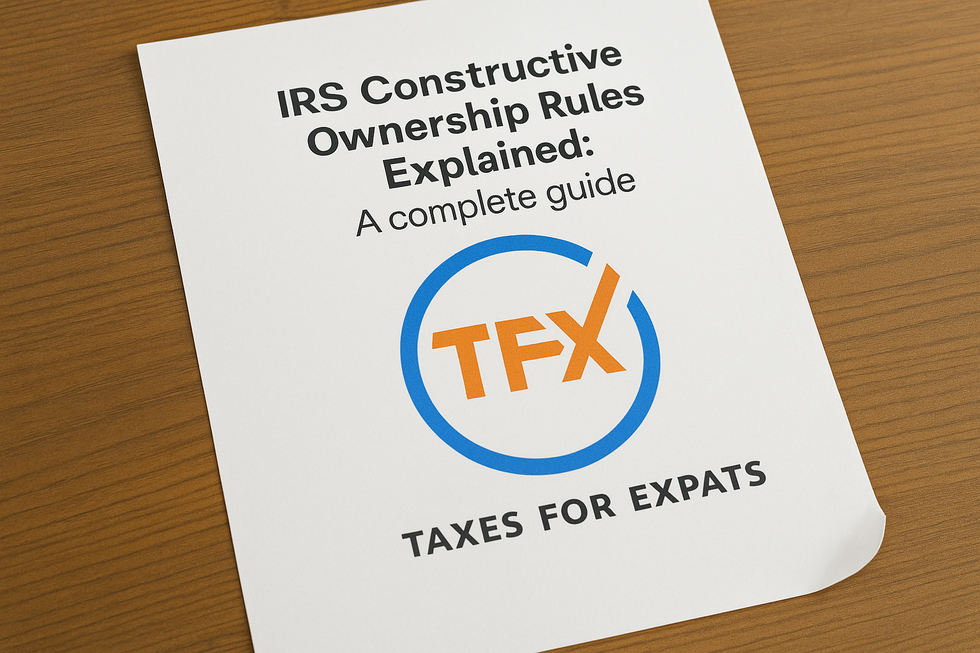IRS Constructive Ownership rules explained: A complete guide

Constructive Ownership is more than a technical tax term – it is the way the IRS prevents taxpayers, corporations, and foreign companies from sidestepping reporting thresholds. This guide tells you about how these rules apply in practice, why they matter, and where they trigger reporting duties. By attributing shares held by family or entities, the rules can turn a small indirect stake in a foreign corporation into a filing obligation, or even tip an entity into CFC status with major tax consequences.
This article is brought to you by Taxes for Expats – a leading firm that helps Americans abroad understand how attribution rules create CFC exposure and filing duties. Our team ensures you stay compliant while avoiding costly penalties, with clear guidance tailored to cross-border ownership.
An overview of constructive ownership and its impact
In tax, constructive ownership means you are deemed to own stock or interests that are actually held by related persons or entities, including through options. The rules look through spouses, parents, children, certain trusts, partnerships, corporations, and option rights to compute ownership for tests and filings. When those tests involve a foreign corporation, the look-through can make you a filer even with zero shares in your name.
Constructive ownership rules exist to stop threshold-gaming and ensure the right parties report and pay US tax. They drive who files, who includes income, and when penalties can apply.
- A CFC exists when US shareholders (each at least 10% by vote or value) own, directly or via attribution, more than 50% of a foreign company. This turns on sections 951(b), 957, and 958.
- Attribution can create filing for Forms 5471, 8865, 8621, and 5472 even without direct shares, because each form’s tests import look-through rules.
- Options are treated as owned stock for these determinations – a small warrant can push you over 10% or 50% lines.
NOTE! Before we look at the below, Direct ownership refers to the shares you personally hold in a company, while constructive ownership is an IRS concept that can attribute shares owned by related parties or entities to you. With those mechanics in mind, here’s how the two concepts compare in practice.
| Aspect | Direct ownership | Constructive ownership |
|---|---|---|
| What counts | Shares you legally hold | Deemed shares via family, entities, or options |
| Family look-through | Not applicable | Spouse, parents, children, certain descendants |
| Entity look-through | Not applicable | Partnerships, trusts, and corporations by proportion |
| Options | Only when exercised | Count as owned even before exercise |
| Typical thresholds | Your actual % only | Deemed % can reach 10% or >50% tests |
| Common filings | Often none if under thresholds | May trigger 5471/8865/8621/5472 based on attribution |
The table above highlights the key differences between the two and shows why this distinction is central when applying the IRS constructive ownership rules.
Where do IRS constructive ownership rules apply most?
Constructive ownership rests on specific Code sections and regulations. Core anchors include IRC 267, 318, 544, and 958, with Subpart F and PFIC rules completing the framework. Together, they determine when options, family ties, and entities cause you to be treated as an owner. These legal rules drive the key areas below – the places where the outcomes and filings change most.
CFC (Controlled Foreign Corporations) and Subpart F
A CFC exists when US shareholders control more than 50% of the vote or value, directly, indirectly, or constructively. A foreign corporation makes a US person a United States shareholder at 10% or more of the vote or value, which can trigger Subpart F inclusions. Attribution under 958 applies 318 rules to pull ownership through entities and options.
Attribution rules for related parties (family, corporations, trusts)
Family attribution under 318 covers spouse, parents, children, and grandchildren; options are treated as owned, which is classic constructive ownership of stock. Section 267 disallows losses on sales between related persons, and those relationships often hinge on constructive ownership of property.
Trust and corporate attribution rules extend ownership through entities using defined proportionate or control thresholds.
PFIC (Passive Foreign Investment Companies)
A company is a PFIC if 75% or more of its gross income is passive, or 50% or more of its assets produce passive income.
These determinations sit alongside attribution and reporting rules that push annual Form 8621 obligations for many investors. PFIC status interacts with other ownership regimes but follows its own statutory tests.
Partnership and S-Corporation rules
Under 318, ownership held by or through partnerships can be attributed proportionately to partners, and certain corporate look-through rules apply.
Form 8865 thresholds rely on 267(c) constructive attribution; that’s why constructive ownership rules for partnerships matter for 10% and 50% tests. S corporations are corporations for 318 purposes, so corporate-to-shareholder and shareholder-to-corporation attribution rules can reshape who crosses key lines.

Attribution types & driving tax outcomes
These four paths show how constructive ownership flows through family and entity layers. Grasping them sets up the thresholds you’ll use elsewhere in corporate, partnership, and international rules.
- Family Attribution – how ownership moves through relatives: An individual is treated as owning stock held by a spouse, parents, children, and grandchildren – siblings are not included. Adoption counts, and family-to-family double attribution is blocked.
- Entity-to-Owner Attribution – corporation to shareholder: If a person owns 50% or more (by value) of a corporation, they are treated as owning a proportionate share of stock that the corporation owns. Some regimes modify this – Form 5472 substitutes 10% for that test – often relevant when a foreign corporation sits atop a US entity.
- Owner-to-Entity Attribution – shareholder to corporation: When a person owns 50%+ of a corporation, the corporation is deemed to own stock held by that person, which can influence CFC status under section 958’s attribution framework.
- Indirect Attribution – layered ownership through entities or options: Options (and chains of options) are treated as owned, and (outside specific stop-rules) constructively owned stock can carry through to the next link. Anti-chain limits prevent re-attribution across family members and certain entity hops – key guardrails within the constructive ownership rules.
Everyday ownership situations made clear
Constructive ownership rules can turn small stakes into big obligations. A husband holding 6% and a wife with 5% may together cross the 10% threshold, creating filing needs with a foreign corporation. The same applies when companies share 80% ownership and fall under corporate group tests.
International structures bring extra pressure when a CFC is formed through family or entity attribution. Trusts also matter, since beneficiaries or grantors can be treated as owners even without direct shares. Each of these cases shows how constructive ownership can quietly change tax outcomes.
Core risks, complex structures & compliance pitfalls
Ownership shifts on paper through constructive ownership – and those shifts can silently flip filing thresholds, trigger forms, and extend statutes. Below, scan the most common mistakes first, then see the penalties that follow if attribution is missed.
- Many teams test only direct percentages and miss attribution that bites at filing time. Entity layers and family ties can change outcomes overnight.
- Assuming a foreign corporation under 10% direct ownership needs no Form 5471, even when family/entity attribution pushes you over key thresholds.
- Overlooking downward attribution that can make an entity a CFC despite no single US person holding 10% directly.
- Skipping Form 5472 for a foreign-owned single-member LLC that pays its owner or affiliates – pro-forma 1120 plus 5472 still applies.
These errors multiply inside chains with trusts, partnerships, and options. Next, we’ll flag complex structures that require extra care.
- Trusts and estates – beneficiaries are attributed stock in proportion to actuarial interests, and remote contingent interests are excluded; re-attribution limits apply.
- Multi-tier entities with options/warrants – options count as ownership, including chains of options, which can push you past 10%, 50%, or 80% tests.
- PFICs held through pass-throughs – indirect shareholders still face annual Form 8621 reporting under 1298(f).
IRS penalties for non-compliance
Penalties often hit when constructive ownership rules make you a filer even without direct shares. Form 5471 starts at $10,000 per annual period per corporation, then $10,000 per 30 days after 90 days, up to a $50,000 cap. Form 5472 is $25,000, then $25,000 per 30 days after notice – no maximum.
Form 8865 carries $10,000 per year plus $10,000 per 30 days after 90 days, and failing to file Form 8621 can suspend assessment until three years after PFIC information is reported under 6501(c)(8).

Comply with IRS constructive ownership
Staying compliant requires mapping attribution across people and entities – then matching it to the right filings. The steps below summarize tax effects, required forms, and when to involve a specialist.
- Tax implications – Attribution can make you a “US shareholder” at ≥10% of vote or value, and if US shareholders own >50% by vote or value the company becomes a CFC, driving Subpart F/GILTI exposure and Form 5471 duties; late or incomplete 5471s draw a $10,000 initial penalty, plus $10,000 per 30 days after notice, capped at $50,000.
- Required forms – Constructive ownership rules don’t just shift percentages – they decide which IRS forms you must file. Each form has its own thresholds, attribution rules, and penalty regime:
- Form 5471 – For interests in a foreign corporation when category rules or attribution make you a filer; penalties as above.
- Form 8865 – For foreign partnership interests at 10%/50% thresholds determined under section 267(c) (siblings count); $10,000 initial penalty with continuation penalties after 90 days.
- Form 8938 – File when living-abroad thresholds are met: $200,000/$300,000 (single) or $400,000/$600,000 (joint); penalties are $10,000 plus up to $50,000 for continued failure.
- Form 5472 – For 25% foreign-owned US corporations and foreign-owned disregarded entities with reportable related-party transactions; $25,000 penalty, plus $25,000 per 30 days after 90 days.
- Form 8621 – Annual PFIC reporting under section 1298(f) for direct or indirect shareholders.
Together, these forms show how attribution rules drive reporting even when you have little or no direct ownership.
When to seek expert expat guidance
Complex webs of entities, trusts, and family attributions make compliance risky – and constructive ownership rules can quietly trigger forms you never expected. From Form 5471 to 8865 and beyond, the smallest misstep can cost thousands in penalties or keep your return open for years.
That’s why Taxes for Expats gives Americans abroad clear, year-round guidance – so you stay compliant with IRS requirements without the stress.

FAQ
Yes – 267(c) includes siblings; 318 does not.
It substitutes a 10% test and generally blocks foreign-to-US downward attribution.
Yes – unexercised options, including chains, are treated as owned stock.
Yes – it can create US shareholder/CFC status unexpectedly.
Yes – the statute can remain open until three years after Form 8621 is filed.



